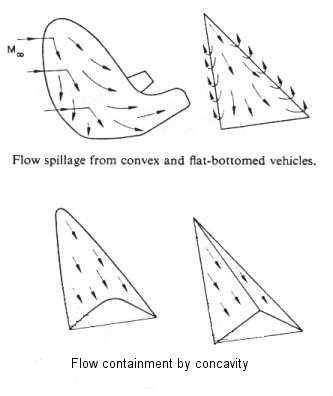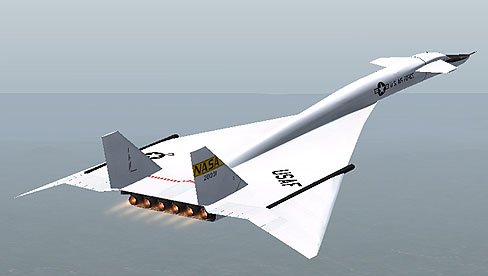

Aspirespace Rocket Engineering Society
What is a Waverider?
We at Aspirespace are very keen on the waveriding concept. You’ll notice that several of our spaceplane designs incorporate waveriding features. But what exactly is waveriding?
When it comes to generating Lift, the best supersonic aircraft shape is a simple wedge inclined at an angle (known as the angle of attack) to the incoming air. The underside 'wedges' into the air, compressing it to generate Lift. (The upper surface doesn't do anything.) The wings and the fuselage are often blended together for aircraft that travel at supersonic speeds, so the wedge is the whole aircraft, not just the wings.

Imagine a toy model of a typical lifting-body (e.g. a Space Shuttle) held upside-down and at an angle under a running tap. The water will hit the underside and spread out over the surface, but as well as running out over the back, the water will also spill out over the edges because the underside is either flat or convex: a spanwise flow is established:
This water flow is more than just an analogy to supersonic airflow: the water reacts to changes in height on the model undersides, exactly as airflow under the real vehicle does. The Space Shuttle loses a 1/4 of its possible lift due to underside air spilling sideways over the edges of its wings.
The underside of a waverider model is concave, therefore the water (airflow) will tend to stay in the middle of the underside before running out over the back, inhibiting spanwise flow and spillage.
The two Waveriders shown opposite are deeply concave; the one on the right is known as a 'Caret wing' because when viewed from the front it looks like your keyboard's caret symbol.
Actually, only the underside areas near to the wing leading edges need be concave to 'wall-in' the airflow; the underside of the Caret wing for example can be filled-in to a large degree, which gives more fuselage internal space, and a lower vehicle centre of gravity (CG) to aid stability.
Some degree of concavity can be added to just about any supersonic delta-winged aircraft; every little helps improve Lift. Both the XB70 Valkerie supersonic bomber shown here, and the British TSR2 supersonic aircraft, had drooped wingtips to give a bit of underwing concavity.


The other feature that helps contain underside flow is a sharp nose and leading edges. You'll have noticed that in contrast, the Space Shuttle has very rounded nose and edges because of its thermal protection ethos. This convexity at the edges just promotes spillage of the flow.
Waveriders typically employ sharp nose and wing leading edges: shockwaves generated by a sharp edge appear to emanate directly from the tip of the edge, and so a waverider appears to ride atop a shockwave attached to its edges: hence the name 'Waverider'.
For more information on waveriders see our technical papers page.
his diagram shows a side view of the wedge, which is assumed to have infinite wingspan in the direction normal to (out of) the page. This imaginary wedge, and the flow around it, are called two dimensional, because there is no flow in the direction of the third dimension, the direction normal to (out of) the page.
Just as with real subsonic aircraft, the finite wingspan of a real supersonic aircraft causes unwanted spanwise flow components (in the 3rd dimension, along the wing span) caused by the wingtips.
These wing-spanwise flows degrade performance: some of the compressed underside air leaks out over the wingtips and so some Lift is lost.
Waveriders are any supersonic aircraft that has underside features designed to minimise these spanwise flows and so retain as much of the underside Lift as possible. It does this by having some underside concavity:




